
mkt33
[PuristS]
5252

A sampling of Martin Braun's astronomical timepieces
This past weekend Royal Jewelers invited collectors and enthusiasts to visit German watchmaker Martin Braun in Andover Massachusettes. It was Mr. Braun’s last stop in his Basel 2007 debut US tour which was very well received around the country.

Royal Jewelers was busy and full of holiday shoppers but Mr. Braun and Mr. Lawrence Rubin (US distributor for Martin Braun) were kind enough to give PuristSPro a “guided tour” of the collection.



The highlight of the Basel 2007 collection is The Selene. The Selene features the largest moonphase display in the marketplace (13mm) and its unique mechanism allows the moonphase to be set precisely down to the minute. The Selene uses glass disks to display the realistic surface features of the moon utilizing printing techniques first invented by contact lens manufacturers.

Before starting his own company, Martin’s family business specialized in case construction. CCM Braun, owned by Martin’s father Karl, was well known and respected in the industry. Martin continues his family’s heritage and demonstrates this know how with the exotic “falcon claw” case construction of the Selene.

Overall the falcon claw case measures 44mm in diameter. Notice how the crown design is carried into the side profile of the lugs. The lugs are curved in multiple planes and they take half an hour a piece to mill in the CNC machine.

The thick fluted design on the sides of the case. The frosted surfaces are the result of sandblasting. Martin explained that in order to achieve this decorative finish a complete “negative” of the case had to be constructed to protect the other surfaces during the sandblasting process.

The movement is the newly designed MAB88. Martin spent 3 years designing this original automatic movement which is now being constructed by the vertically integrated manufacturing capabilities of Watchland. This movement is exclusive to Martin Braun watches and serves as the base engine for all of the Basel 2007 models.
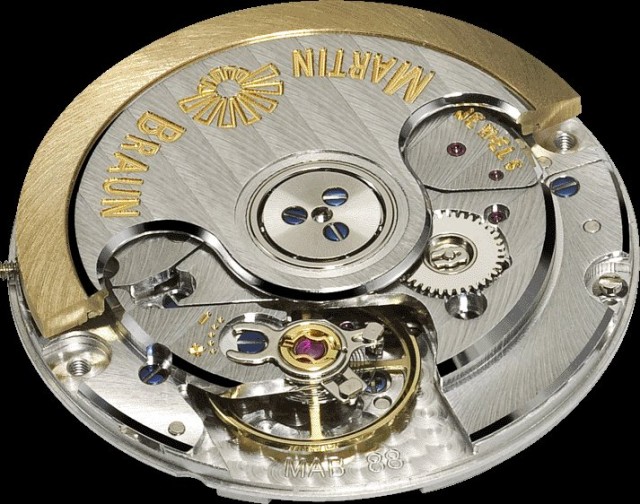

The lunar theme is carried to the case back where a porthole in the shape of a cresent moon allows the owner to gaze at the movement. The border of this porthole is elevated and requires the use of a 5 axis CNC milling machine to create this back plate. It is difficult to notice this detail in the picture but there are actually two sapphire crystals on the back of the watch. One that is smaller and shaped to fit the porthole, the other circular crystal covers the back of the watch. Martin points out that the smaller shaped crystal is actually much more expensive than the larger piece but he wanted to retain this design detail despite the cost.

Carrying the astronomical theme one step further the Selene may be ordered with the special meteorite dial. This particular piece of meteorite was found in South Africa and selected by Martin personally. The moonphase display was moved to the 12 o’clock position solely for aesthetic purposes.


Next on the display was the rose gold La Belle CP. CP stands for “crown position” so when the onion crown is pulled out to set the time this indicator will flip to the “S (Set)” position. This whimsical complication was added because Martin thought another hand was needed to balance the dial. This rose gold model is a limited edition of twenty five and there are only two examples left in the world. Why is this series almost sold out? Not only is the dial composed of sterling silver and hand guilloched but the movement is also hand engraved, skeletonized, and gold plated. A close look at the engraving and pattern of skeletonization reveals the identity of the other master craftsman whose work is being displayed: it is none other than Mr. Jochen Benzinger. This is the last year of production for the La Belle series and the end of a few years of collaboration between these two German masters.
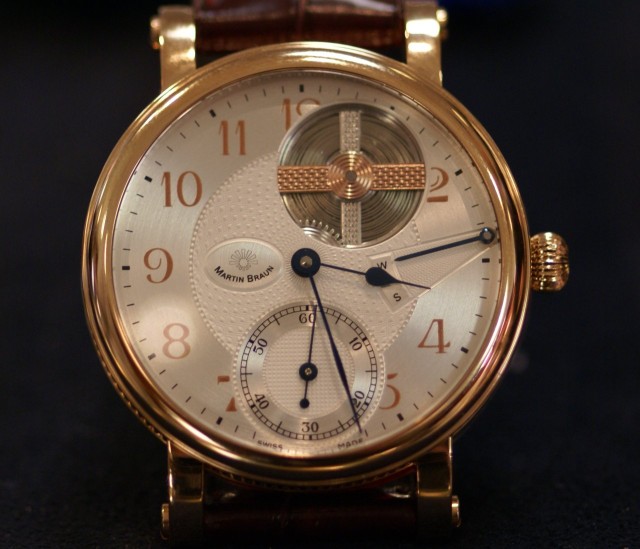

The timepiece which Martin Braun is best known for is the EOS. First introduced in 2002, the EOS indicates the times of sunrise and sunset at the wearer’s chosen location based on the specific degree of latitude and longitude. Controlled by different dials and cams, the correct sunrise and sunset times are displayed using two hands which cross on the dial. These crossed hands have become a Martin Braun trademark. I’ve long admired this watch at a distance but here is a subtle detail close up.
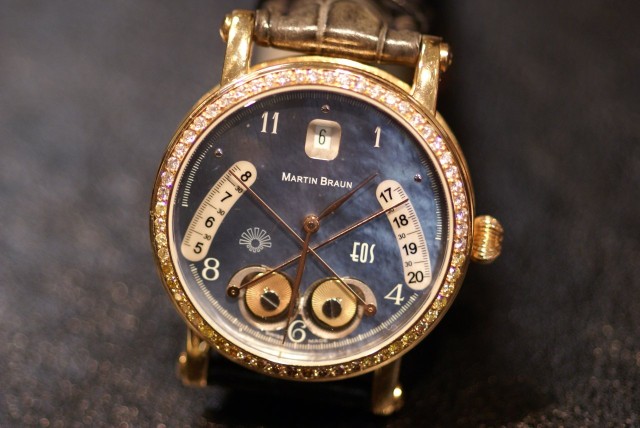
Notice the different colored cams, the yellow gold for sunrise and the rose gold for sunset.

Notice the use of white diamonds on the upper half of the bezel, the yellow and chocolate diamonds on the bottom half of the bezel representing sunset and the evening

The Boreas is derived from the EOS and it also contains an equation of time complication as seen in the display immediately below the date. Martin was able to incorporate this complication without changing the overall dimensions of the movement

Besides the Selene, my favorite model was the Heliocentric.
The Heliocentric’s complication module illustrates the elliptical orbit of the earth around the sun while also displaying the current month around the display’s periphery. Although it is not astronomically correct, the Martin Braun rising sun logo is used cleverly to mark the sun’s position in the center of this display. Notice the subtle use of diamonds on the dial to depict the constellations Ursa Major and Orion. The small blue sphere corresponds to earth's location around the sun's orbit. Eat your heart out FP Journe, there is a Zodiac complication as well!

I tried real hard to understand the Notos with its declination and equation of time complication but I am still confused. Sorry but if I don't understand the complication, I won't wear it.

The sports lineup was next. Here is the Benzol, the Tracer, the GP, and the Dakar series.

I remember seeing the press release about the new Benzol and thinking what a monstrosity of colors and patterns. I have to admit that I was pleasantly surprised about how all the details worked together and formed a really distinctive watch in the metal. Other enthusiasts must have shared the same thought because the three working models that Martin brought with him were sold and the remaining piece on display was the non-working prototype. The skeletonized hands, the use of multiple layers, and the carbon fiber background gave the dial incredible depth and it seemed like the chronograph subdials were floating.
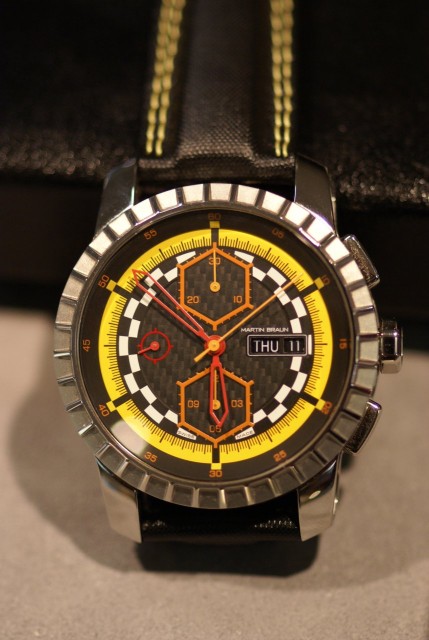
Not quite sure if I appreciate the aesthetics of the new Tracer model. It uses the Valjoux 7750 as its base and according to Martin the 7750 will be the only movement used in Martin Braun watches besides the MAB88.

Here are some shots of the GP and Dakar series. Like the Benzol, the dials were vibrant. The only problem was which color to pick since they all looked very sporty on the wrist.

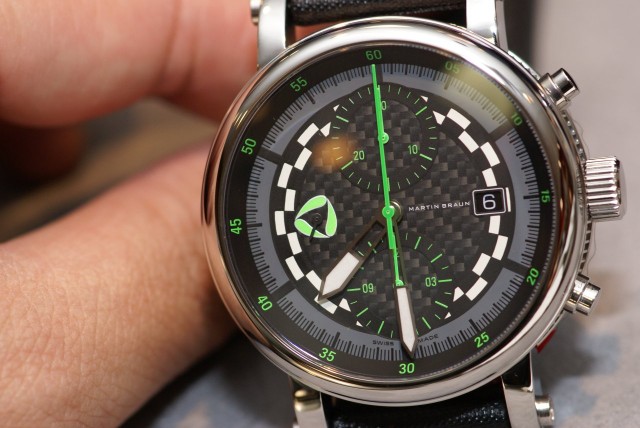
And just in case you thought that Martin could only create complicated watches, here is the Classic utilizing the new MAB88
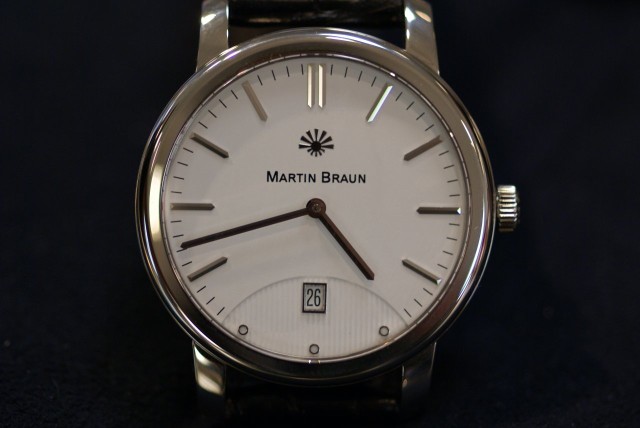
Thank you Martin, Lawrence, and Royal Jewelers for sharing your time with the PuristSPro community.
Stayed tuned for an interview with Mr. Martin Braun where he shares his thoughts about being a german watchmaker in Switzerland, his new role at Watchland, and the meaning of life (seriously).
added to Editor's Pick -Anthony
This message has been edited by AnthonyTsai on 2007-12-13 07:06:38 This message has been edited by mkt33 on 2007-12-13 18:52:56

A sampling of Martin Braun's astronomical timepieces

Thanks Mike. The Notos is a conceptual grande complication...

In this case....

Additional info for you...

Thanks Tim, I think your description and the visual display





